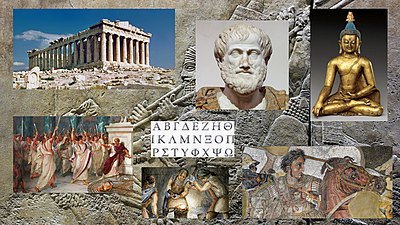| Millennia: | |
|---|---|
| Centuries: |

The 1st millennium BC, also known as the last millennium BC, was the period of time lasting from the years 1000 BC to 1 BC (10th to 1st centuries BC; in astronomy: JD 1356182.5 – 1721425.5[1]). It encompasses the Iron Age in the Old World and sees the transition from the Ancient Near East to classical antiquity.
World population roughly doubled over the course of the millennium, from about 100 million to about 200–250 million.[2]
- ^ "Julian Day Number from Date Calculator". keisan.casio.com.
- ^ Klein Goldewijk, K., A. Beusen, M. de Vos and G. van Drecht (2011). The HYDE 3.1 spatially explicit database of human induced land use change over the past 12,000 years, Global Ecology and Biogeography20(1): 73–86. doi:10.1111/j.1466-8238.2010.00587.x (pbl.nl). Goldewijk et al. (2011) estimate 188 million as of AD 1, citing a literature range of 170 million (low) to 300 million (high). Out of the estimated 188M, 116M are estimated for Asia (East, South/Southeast and Central Asia, excluding Western Asia), 44M for Europe and the Near East, 15M for Africa (including Egypt and Roman North Africa), 12M for Mesoamerica and South America. North America and Oceania were at or below one million. Jean-Noël Biraben, "Essai sur l'évolution du nombre des hommes", Population 34-1 (1979), 13–25 (p. 22) estimates c. 100 million at 1200 BC and c. 250 million at AD 1.[1]